Why do apple leaves curl - what to do, how to process
Almost any problem with fruit trees is primarily reflected in the color and shape of their foliage. And now we are sure that you are interested in the reasons for the folding or twisting of the leaves of the apple tree.
Well, then we will analyze why the leaves of the apple tree can curl and what to do in each case, how to help the tree recover.

Reasons for curling apple leaves
If you are wondering why the leaves of an apple tree curl, then the answer most likely lies in one of the following reasons:
By the way! Leaves can curl in both young apple trees and adults.
- Nutritional deficiency (potassium, magnesium and other elements).
- Pest attack (aphids).
- Fungal disease (powdery mildew, moniliosis, less often fire blight and scab).
Next, we will tell you about each reason in more detail, so that you can easily and correctly determine the cause of leaf curling and take action in a timely manner.
Important! Often the reason for curling the leaves of an apple tree is trite improper watering, especially during a hot period of time, i.e. in summer (excessive drought or overflow). In this case, you just need to adjust your watering regime and the leaves will recover quickly enough.
Lack of food
Naturally, the easiest way to determine the lack of nutrients is by the color and shape of the foliage, for example, according to this picture-diagram:

So, for example, if the lower leaves of an apple tree curl up and turn red, then this clearly indicates a lack of magnesium.
Next, let's talk a little more about potassium and magnesium deficiency.
Lack of potassium (dry around the edges and curl slightly)
If your apple tree leaves curl due to a lack of potassium, then in the future:
- her foliage will turn pale;
- the edges of the leaves will become dry and brittle, they also say that this is a "marginal burn";
- the leaves will develop unevenly and begin to curl slightly.
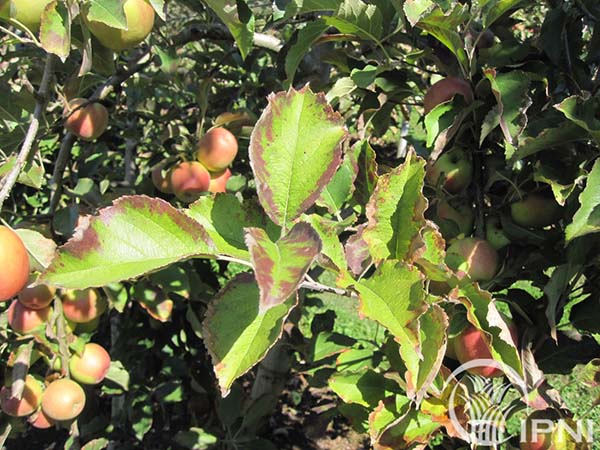
Interesting! As a rule, more mature leaves located in the middle of the shoot (middle part of the branch) are more susceptible to potassium starvation.
As for the negative consequences of a lack of potassium in an apple tree, in this case:
- the plant ceases to receive the necessary nutrition through the leaves due to their damage;
- internodes are shortened;
- the branches are thinning;
- trying to survive, the apple tree lays too many flower buds - as a result, there are many fruits, but they are small and of poor quality;
- potassium deficiency negatively affects the wintering of the plant.
How to be? What to do? Obviously, it is necessary to carry out potash feeding of the apple tree, and this can be done in one of the following two ways:
By the way! The site already has an article about how to properly feed an apple tree in spring , and autumn (after fruiting).
- Perform root dressing (liquid or dry).
Advice! It is necessary to apply fertilizers under all fruit trees and shrubs according to the projection of their crown.
- Carry out foliar feeding, i.e. spray over the leaves.
Note! With root top dressing, fertilizers will not begin to act immediately, but only in the next season, with the exception, for example, of rapidly assimilated potassium monophosphate. However, in any case, if you want the apple tree to stop experiencing potassium starvation and go into the winter “full”, it is necessary to feed on foliage, but reducing the concentration of the fertilizer solution by 2-3 times.
What potash fertilizers are suitable for an apple tree?
- potassium chloride - 30-40 grams per square meter (on average, about 90-120 grams is needed for one adult tree);
- potash salt - 30-40 grams per 1 square meter;
- potassium sulfate (potassium sulfate) - 30-40 grams per 1 square meter;
- wood ash - 100-200 grams per 1 square meter (or 10 liters of water);
- potassium monophosphate - 20-30 grams per 1 sq.m.
Pests
Perhaps the most common cause of apple tree leaf twisting is the harmful activity of aphids, and it does not matter what kind it is.
Red-gall aphid (redden and curl)
If the leaves of the apple tree began to curl (curl) and turn red, and before they turned pale, then these are the tricks of such a pest as the red-gall aphid.
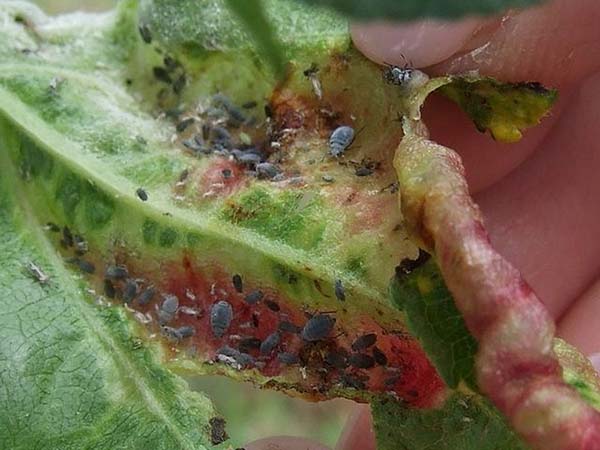
The main feature of damage to the leaves of the apple tree by the red-gall aphid is the appearance on the leaf plates red-cherry or red-yellow swellingswho acquire oblong oval shapeand then the leaves start curl to the bottom.
Note! If the infection is very strong, then after a while the leaves are completely covered with galls (turn red), which is why they dry up and subsequently fall off.
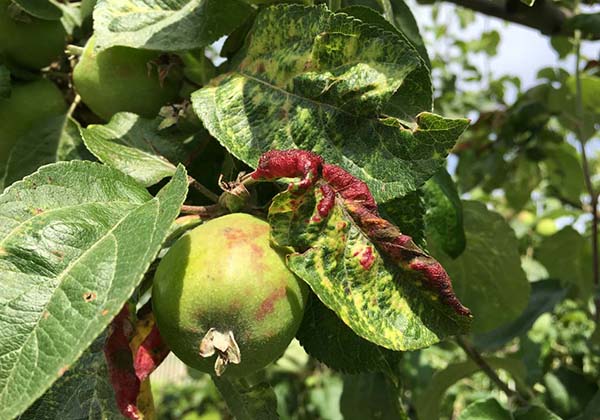
By the way! Get damaged also apple fruiton which appear red spots.
Red-headed aphid nothing does not differ from other types of aphids, which means that ways to fight with her same.
Advice! The site has detailed material about how to get rid of aphids on fruit trees (including apple trees).
Apple green aphid (leaves curl and the tops of the shoots are bent)
Another reason for curling apple leaves is the harmful activity of apple green aphids:
- The leaves of the apple tree damaged by green aphids curl up.
As a rule, it is young leaves that suffer.
- The shoots themselves, or rather, their tops are bent.
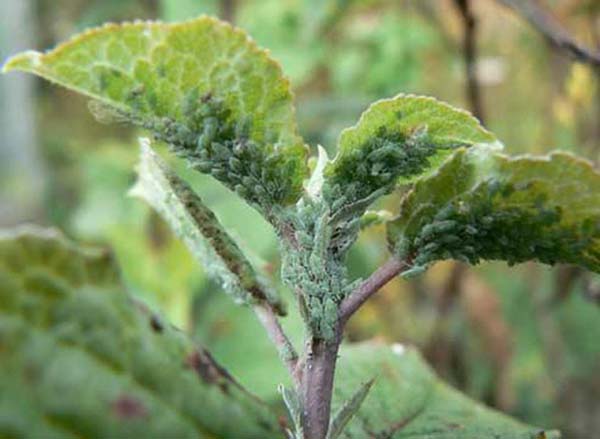
- Red spots may appear on the fruit.
As stated earlier, the methods of dealing with any kind of aphids are the sameThe apple green aphid is no exception.
Therefore, we suggest that you familiarize yourself with this article on countermeasures for aphids on fruit trees (apple trees, pears, etc.).
Leaf roll (leaves are rolled into tubes)
If the apple leaves curled up into tubes and then covered with cobwebs on top, then the leafworm caterpillar most likely worked here (made a nest for itself).
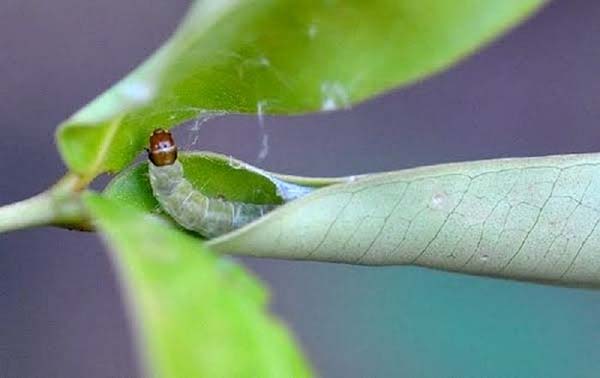
How to deal with a leaf roll on an apple tree?
- Pick off rolled leaves by hand and then destroy (burn).
- Spraying with chemical (For early spring spraying from the wintering stages of pests - Prophylactin, drug 30 plus, during the growing season - Aliot, Kinmiks, Gerold, Sharpei, Senpai, Neofral, Avant, Prokleim, Voliam Flexi and biological insecticides (Akatsilin, Bitoxibaepidatsil Fitoverm).
Diseases
Next, let's talk about diseases of the apple tree, one of the symptoms of which is folding or curling of leaves.
Powdery mildew (curdles and a white bloom appears)
Symptoms of powdery mildew disease are as follows:
Leaf buds infected since autumn form shoots in which a diffuse development of infection is observed.
- On the first young leaves, a pale white powdery coating (fungus) is already noticeable.
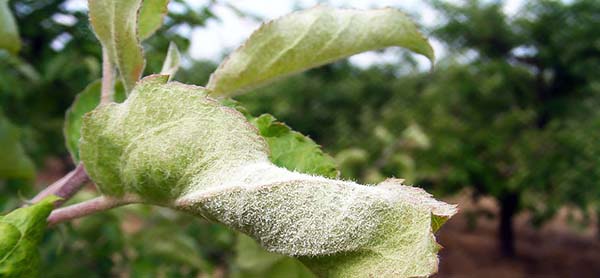
- As the leaves open further and the shoots grow, the bloom becomes more intense and eventually covers all the leaves and the non-lignified part of the shoots.
Affected shoots are distinguished by shortened internodes and narrow, curved (twisted) lanceolate leaves. In addition, the organs of flowers are strongly deformed, due to which the ovaries are not formed.
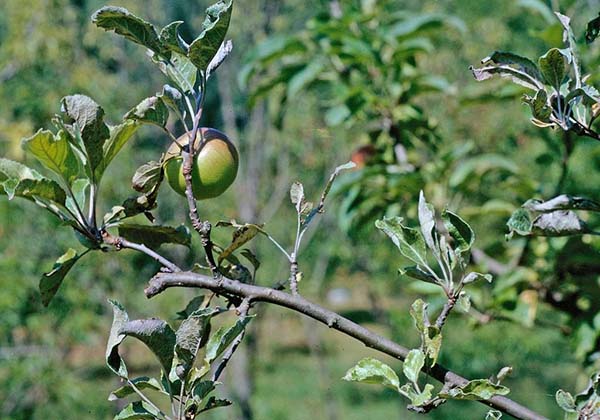
- Then, as it develops, the powdery (whitish) bloom becomes darker in color.
- Affected leaves are necrotic and fall off.
Thus, the danger of powdery mildew for an apple tree is as follows: fungal disease inhibits plant growth, suppresses its photosynthetic activity of leaves, and also destroys inflorescences, as a result, the yield can decrease up to 80%. Moreover, declines (as in the case of "potassium starvation") winter hardiness apple trees.
Agrotechnical methods for preventing apple powdery mildew are as follows:
- cutting infected shoots in the early spring and summer periods;
- prevention of excessive thickening of apple and other plantings;
- competent watering;
The fact is that the development of powdery mildew is also facilitated by a sharp fluctuation in humidity. The most favorable temperature is +18 .. + 25 with a simultaneous high saturation of the air with vaporous moisture.
Note! In drops of water, as well as when the temperature drops, the fungus does not develop.
- proper feeding (in no case should you overfeed the plant with nitrogen fertilizers, otherwise it will fatten, give too much foliage);
- growing disease resistant varieties.
How to treat an apple tree from powdery mildew, the best fungicides (in parentheses are indicated - the active substance, method of penetration and action, chemical class):
- Skor (Difenoconazole, contact-systemic fungicide of protective, curative and immunizing action, class - Triazoles);
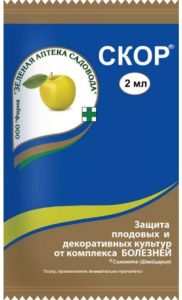
- Raek (Difenoconazole, contact-systemic fungicide of protective, curative and immunizing action, class - Triazoles);
Skor and Rajok are complete analogues.
- Topaz (Penconazole (Topaz), systemic fungicide of protective action, class - Triazoles);
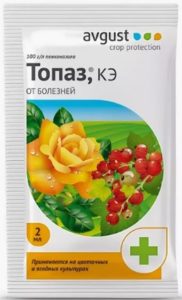
- Strobi (Kresoxim-methyl, systemic fungicide of protective and healing action, class - Strobilurins);
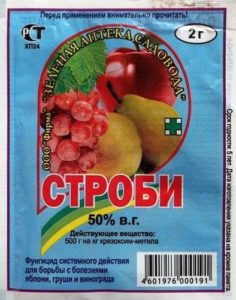
- Bactofit (Bacillus subtilis strain IPM 215, contact fungicide of protective, curative and immunizing action, class - Bacterial fungicides + biological pesticides);
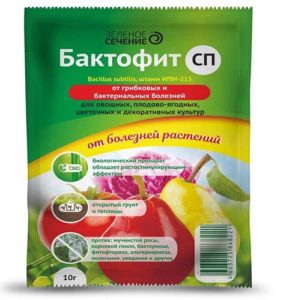
- Sporobacterin (Bacillus subtilis and Trichoderma viride, strain 4097, contact-systemic fungicide of protective, curative and immunizing action, class - Bacterial fungicides + biological pesticides);
- Fitosporin (Bacillus subtilis strain 26 D, systemic fungicide of protective and curative action, class - Bacterial fungicides + biological pesticides).
By the way! The site has detailed articles about how to treat apple trees for diseases and pests in spring (including powdery mildew), and autumn (eradication treatment).
Moniliosis or monilial burn (leaves roll up and dry out) and bacterial burn (leaves turn black and dry)
If the leaves of the apple tree at first curled up, a then and at all dried up sharply (as if they were set on fire), then you should know - this is a monilial burn. Also, this fungal disease affects the fruits: apples begin to rot right on the tree (this phenomenon is called fruit rot).
Note! The site has detailed material about what is apple moniliosis and how to deal with it.
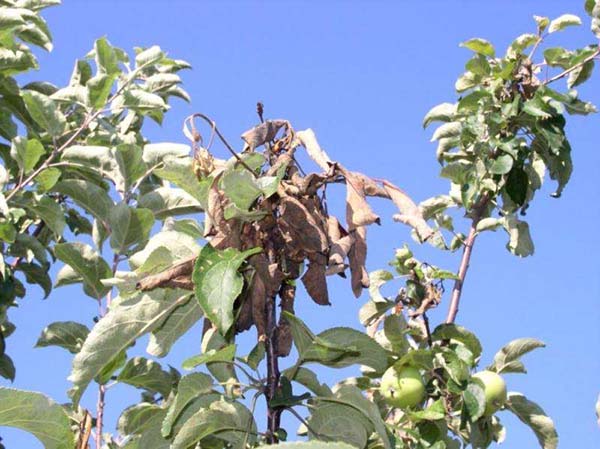
Important! Do not confuse monilial burn with fire blight. In this case, the leaves do not just dry out, but rather sharply turn black.
Only correct agricultural technology and planting resistant varietiesas well as preventive spraying with a biological preparation Fitolavin.
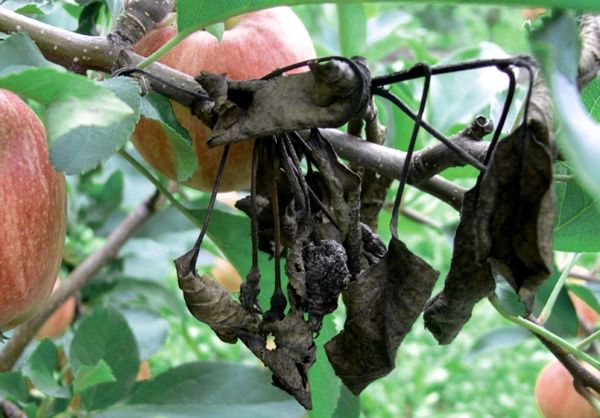
Scab (oily brown spots on the leaves)
Sometimes the leaves can curl up if the apple tree is damaged by scab (oily brown spots appear on the leaf plates). In this case, the fruits also suffer (cracks form on them, which are then covered with a black crust).
Note! The site also has a detailed article on how what is apple scab and how to treat it.
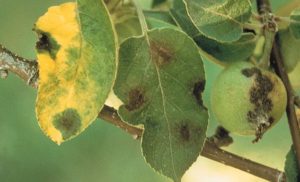
Thus, now you know what can cause curling of the apple tree leaves, which means you can determine what happened to your fruit trees, how you can quickly help it, how to process it or feed it.

